Pacific Rim, Week 10: Japanese
Again, my classmates and I were pleasantly surprised at how different Asian cuisine is from country to country--similar ingredients and cooking methods, but slight changes in ingredients, and the difference was inspiring.
Here's my to-go box (a.k.a. Hun's dinner and the next day's lunch for both of us), upward from chicken teriyaki at bottom: pork tonkatsu, asparagus and carrot tempura, beef sukiyaki, with more chicken teriyaki at top right
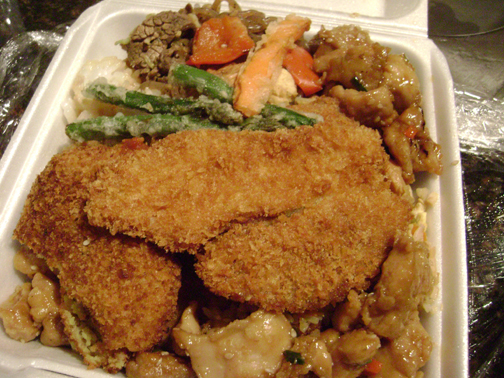
Horenso and tomago soup. Tomago is egg, and horenso is spinach, through in some Hondashi, and you basically have egg drop soup with spinach and a dominating fish flavor--yum yum yum! Chef had us add some red, white, and green Kamobongo fish cakes . . . he's Italian.
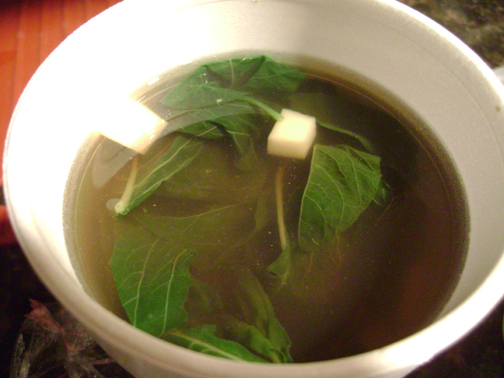
Japanese sticky rice. Using short grain rice, it could be nothing but sticky!
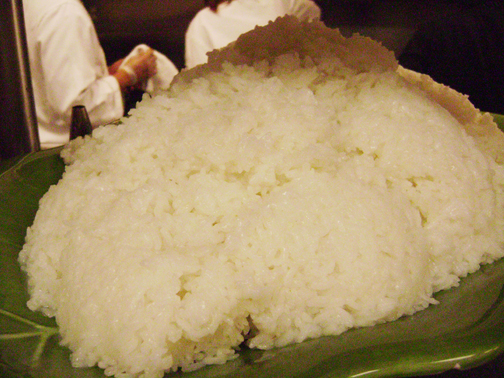
Tempura veggies
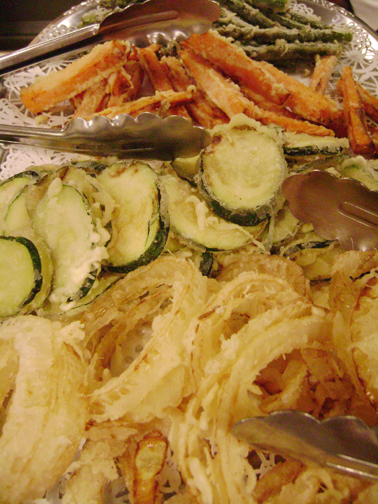
Teriyaki beef
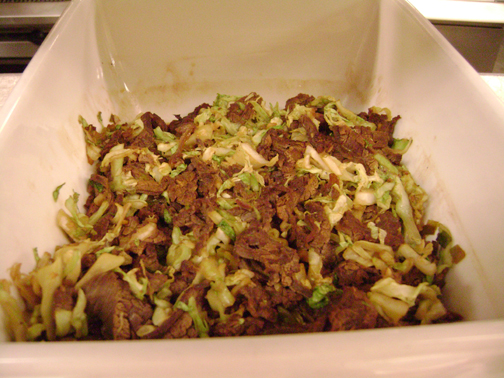
Pork cutlet Tonka(t)su Japanese style. Chef added the "Japanese style" because, as Hun and I learned during dinner at a Hawaiian joint the day before, Hawaii has tonkatsu, too (and they're both delicious). Yay with the tasty crispy breading!
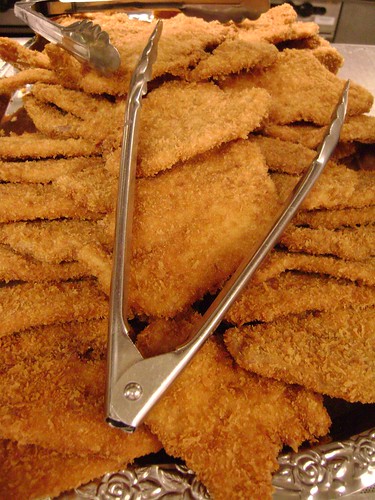
Teriyaki chicken stir-fry. Mmm, sugar-sweetened sticky sauce!
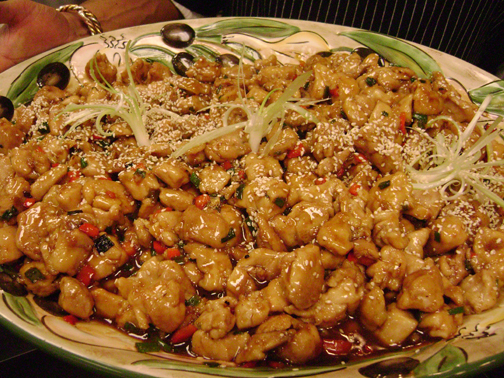
Yakitori, now with pineapple hat! Fitting, I guess, because it tasted pineapply!
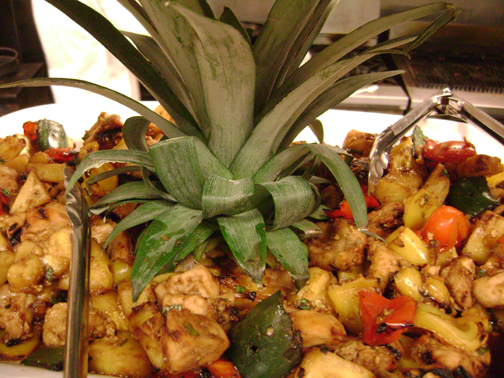
Benihana fried rice. Of course, we didn't actually cook it on a hibachi--it's just Benihana's recipe.
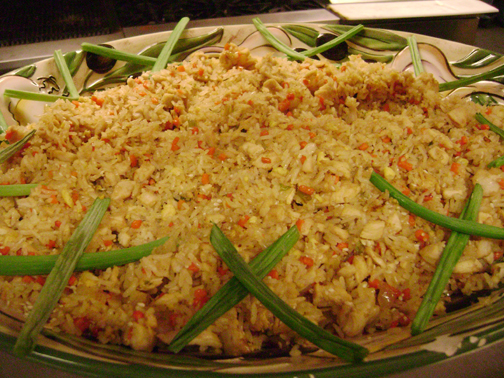
Japanese potato dumpling (curry Korokke)--yes, once again, we made curried potato croquettes. Yum yum yum!, and uber hooray for crispy coating.
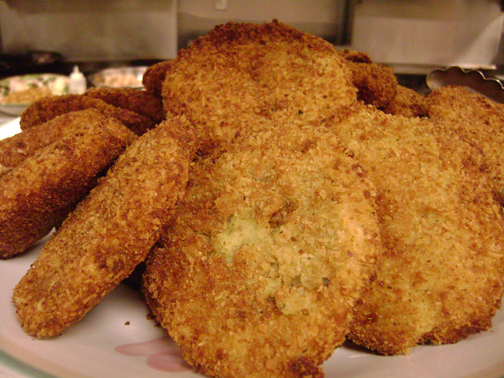
Beef sukiyaki (with shirataki, aka yam noodles)
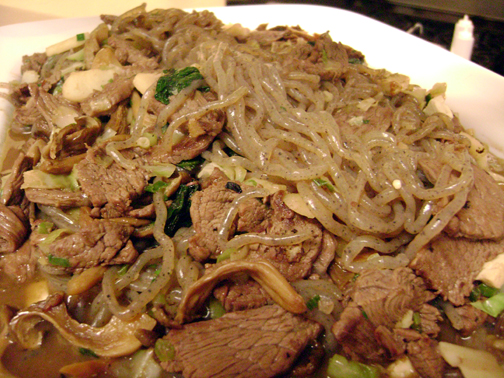
Notes:
Shirataki are low-carb, low-calorie noodles made from a tuber called "Devil's Tongue." They're low on flavor, meaning they're highly efficient and soaking up the flavor of the ingredients you cook them in, but they're ... well ... high in texture--chewy can be an understatement. Not that I was turned off by their texture--I thought it worked well with the beef!
Panko! When I was taking French Cuisine classes, our chef-instructor told us that panko was made by shooting batter at a super-heated steel wall. The batter would cling to the wall, cook, then fall as panko crumbs. He was full of crap. It's really just a coarse grind of usually crustless bread, though if crusts are included, then it's tan panko.
"So what's the secret," Hun asked. "Why is tempura batter so light?" Maybe it's the cornstarch, maybe it's the baking powder. My learnings say it has to do with the cold water in the batter. Wikipedia agrees!
Chef drew a loose comparison of tonkatsu sauce to Heinz 57. It's not the same, but if you're desperate, it will do in a pinch.
Here's my to-go box (a.k.a. Hun's dinner and the next day's lunch for both of us), upward from chicken teriyaki at bottom: pork tonkatsu, asparagus and carrot tempura, beef sukiyaki, with more chicken teriyaki at top right

Horenso and tomago soup. Tomago is egg, and horenso is spinach, through in some Hondashi, and you basically have egg drop soup with spinach and a dominating fish flavor--yum yum yum! Chef had us add some red, white, and green Kamobongo fish cakes . . . he's Italian.

Japanese sticky rice. Using short grain rice, it could be nothing but sticky!

Tempura veggies

Teriyaki beef

Pork cutlet Tonka(t)su Japanese style. Chef added the "Japanese style" because, as Hun and I learned during dinner at a Hawaiian joint the day before, Hawaii has tonkatsu, too (and they're both delicious). Yay with the tasty crispy breading!

Teriyaki chicken stir-fry. Mmm, sugar-sweetened sticky sauce!

Yakitori, now with pineapple hat! Fitting, I guess, because it tasted pineapply!

Benihana fried rice. Of course, we didn't actually cook it on a hibachi--it's just Benihana's recipe.

Japanese potato dumpling (curry Korokke)--yes, once again, we made curried potato croquettes. Yum yum yum!, and uber hooray for crispy coating.

Beef sukiyaki (with shirataki, aka yam noodles)

Notes:
Shirataki are low-carb, low-calorie noodles made from a tuber called "Devil's Tongue." They're low on flavor, meaning they're highly efficient and soaking up the flavor of the ingredients you cook them in, but they're ... well ... high in texture--chewy can be an understatement. Not that I was turned off by their texture--I thought it worked well with the beef!
Panko! When I was taking French Cuisine classes, our chef-instructor told us that panko was made by shooting batter at a super-heated steel wall. The batter would cling to the wall, cook, then fall as panko crumbs. He was full of crap. It's really just a coarse grind of usually crustless bread, though if crusts are included, then it's tan panko.
"So what's the secret," Hun asked. "Why is tempura batter so light?" Maybe it's the cornstarch, maybe it's the baking powder. My learnings say it has to do with the cold water in the batter. Wikipedia agrees!
Chef drew a loose comparison of tonkatsu sauce to Heinz 57. It's not the same, but if you're desperate, it will do in a pinch.
Comments
If that's Japanese style tonkatsu, what is Hawaiian style?